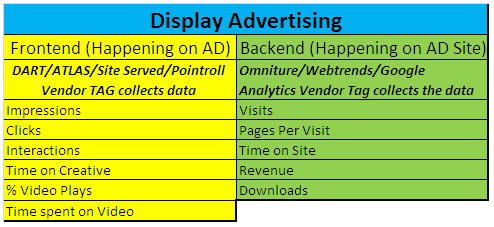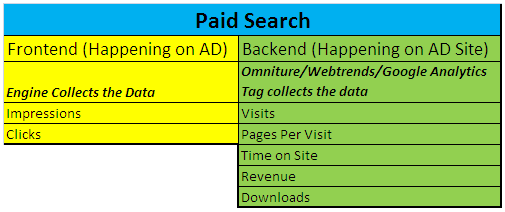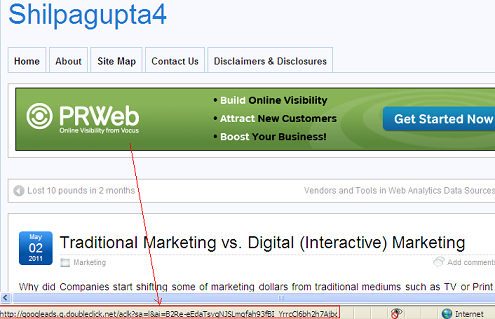With multitude of digital data available for analysis on Internet, it is imperative to aggregate/ merge data to produce actionable insights. Let us understand digital data integration by two examples below.
Display Advertising
The difference between frontend and backend data for Display is explained in Table below.
Why data aggregation is required?
- Several times impressions are served by ADServer such as DART/ATLAS and action data on client website is captured by other vendor such as Webtrends, Omniture, Google Analytics etc. In case of Rich media the ads might be served by Pointroll or any other rich media vendor.
- As data is collected through different vendors, it is imperative to merge it properly to make actionable insights.
- The task is to merge frontend/backend data and segment data by Site, Placement, Creative, Geography, Day Parting etc. for Display Advertising.
How to set Digital Display Campaign for proper data integration?
- Have you ever noticed a Display visit URL? For example when I clicked on PRWeb AD on shilpagupta4.com I noticed the following URL. Notice the parameters at the end of URL highlighted in green.

http://service.prweb.com/go/psg_dcobrand_ba_q311/?utm_source=google&utm_medium=cpc&utm_campaign=psg_dcobrand_ba_q311 - If Display AD is tagged (trafficked) properly and we click on Display AD, URL will have parameters appended to its end that will capture all the campaign information.
- As AD appears on a website an impression tag fires, someone click on it, click tag fires and with the click tag a referring url is generated on brand website and action tag is fired which captures the referring url. Everytime a tag fires all data is stored in the database and using these parameters at the end, it is easy to find out which campaign, site, placement, creative the traffic came from and what those particular consumers did on the site.
- So when an AD appears frontend data is stored by the frontend vendor and backend is stored in database by backend vendor and data can be easily merged using same parameters in both databases (frontend &backend).
Paid Search Campaign
The difference between frontend and backend data for Paid Search is explained in Table below.
Why data aggregation is required?
- For Paid Search, often times the task is to merge frontend and backend and segment it by keyword, keyword type, adcopy etc.
How to set Paid Search Campaign for proper data integration?
- Notice a Paid Search visit URL. For example when I clicked on Paid Search Geico AD on Google.com I noticed the following URL. Notice the parameters at the end of URL highlighted in green.

http://www.geico.com/landingpage/go168.htm?soa=56543&gclid=CNe83ILI8qoCFQ865Qodn2bZMQ - Again, notice the referring URL parameters, URL parameters can help track specific keyword, adcopy, keyword group etc.
- Similar to Display Advertising, when a Paid Search AD appears frontend data is stored by the frontend vendor (engines such as Google, Bing etc.) and backend is stored in database by backend vendor and data can be easily merged using same parameters in both databases (frontend and backend).
In sum, make sure all your campaigns are tagged properly in order to produce complete data and make actionable insights.
Do you agree? Do you know of better method or above is a standard procedure for your brand as well? Please share your thoughts via comments below.


thank you for this informative blog.